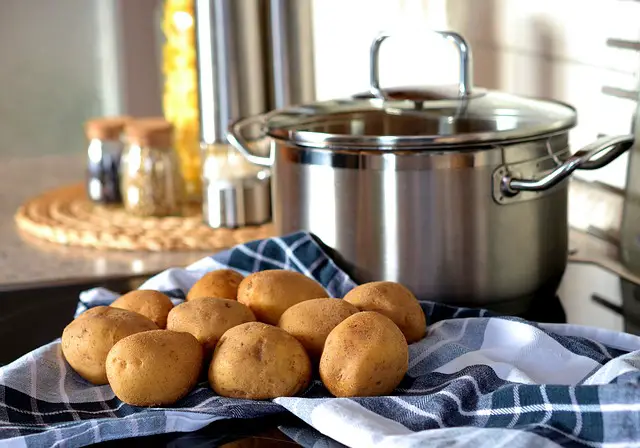Potatoes are semi-perishable produce, and just like many other vegetables, they too can be packaged and stored inside the freezer to further extend their already manageable shell life.
But in order to do so, they require proper blanching to further decelerate their fairly quick rate of deterioration and also to preserve some qualities such as color and texture, although potatoes meant for French fries are best frozen using an alternate method other than blanching.
Below are quick and simple instructions on how to properly blanch potatoes at home. The full details can be found in the rest of the article, alongside a tutorial on how properly incorporate frozen potatoes into dishes.
How to blanch potatoes
- Step 1: Scrub potatoes thoroughly in cold water.
- Step 2: Blanch for 4 to 10 minutes depending on the size of the potato.
- Step 3: Cool potatoes in an iced water.
- Step 4: Package potatoes in a plastic freezer bag.
- Step 5: Put in the freezer for up to one year.
The above instructions are for blanching new potatoes using the water blanching method. Steam can also be used but it’s general not advised because it takes longer and may not fully inactivate enzymes for items the exact sturdiness of potatoes.
In the next section, you’ll see the detailed steps on how to properly blanch potatoes at home. But before that, it’s important to know why you need to blanch them in the first place.
Why blanch potatoes?
Blanching is crucial for many vegetables to properly freeze. It involves cooking them for a predetermined period of time (no more, no less), and then quickly cooling in ice cold water to stop heat activities from within. Such process, for potatoes, has many benefit during freezing some of which include:
- Blanching reduces the risk of exposure to acrylamide when frying or roasting which is suspected to be a probable carcinogen.
- Blanching helps to inactivate enzymes in the potatoes that naturally results in the deterioration of the potatoes with time. This allows them to freeze for longer periods before going completely bad.
- Blanching can help rid the surface of potatoes from bacteria, molds and other organisms on the surface.
- Blanching prevents potatoes from turning black when exposed to oxygen.
- Blanching potatoes can help improve texture of fried potatoes by creating a layer of gelatinized starch at the surface layer. It can also limit the oil absorption which is something highly desired when frying potatoes.
With the advantages of blanching potatoes aside, let us now see how to properly blanch potatoes for storage.
But first, if you’re simply blanching your new potatoes because you think they won’t last in a any corner around the house, you might want to re-think your decision.
Potatoes stored outside the fridge will always boast the better quality than those blanched and refrigerated or frozen.
Plus, when properly stored, potatoes can even last for up to 3 months before they begin showing any signs of deterioration, which in my opinion, is more than enough time to put all of them to proper use.
At this point, you might want to check out how to properly store potatoes at home.
How to blanch potatoes for freezing
1) Choose the right potatoes
Before you begin with any freezing preparation, you want to first of all make sure you choose the right potatoes for freezing. Frozen potatoes are best purposed for boiling, roasting or steaming as the impacts of these cooking methods on the final texture of the potato is minimal.
These potatoes are usually the new or baby potatoes—which are freshly harvested potatoes. Waxy potatoes like the red or bliss variety used in salads or soups are also fair game for freezing. But baking or frying potatoes like the russets usually do not produce good quality potatoes after cooking, especially if they are blanched before freezing.
If you just bought potatoes from the farmers markets and don’t know exactly what variety you have or how old they are, I advise that you first prepare them in small quantity (using this guide) for freezing, and then see how well you like the quality of the final potato.
When choosing potatoes for freezing, make sure to always go for individuals that are smooth and free from wound.
2) Wash, peel, cut and treat potatoes
Next is to prepare the potatoes before blanching. Wash them thoroughly in running water using a brush or soft cloth, to rid them off dirt. You can use a vinegar + cold water to remove some pesticide residue, but don’t worry too much about that because the blanching process itself helps rid a majority percentage of that.
After washing, go ahead and peel the potatoes and cut into ¼ or ½ inch cubes, or leave whole, or whole but peeled if not peeling or cutting respectively.
If the potatoes are peeled, make sure to cover them in a solution containing 1 teaspoon of lemon juice or ascorbic acid in 1 gallon of water for 5 minutes to prevent them from darkening.
3) Blanching potatoes
When it comes to blanching potatoes, there’s one warning that can never be overemphasized which is to always make sure to stick with the timing guidelines given.
Over blanching of potatoes can cause them to loose so much of their crisp texture after freezing and under blanching can make them deteriorate quickly, even during refrigeration or freezing. So you want to make sure you stick to the time so the potatoes are in the right condition of blanching.
Blanching times for different state of potatoes:
- For whole potatoes smaller than 1 to ½ inches in diameter, blanch for 4 to six minutes depending on the size.
- For whole potatoes larger than that, blanch for 8 to 10 minutes.
- For cut potatoes, blanch for 5 minutes or until they turn just crisp.
Water blanching for potatoes
Instructions (as per the current recommendations of the Pennsylvania State University)
Step one: Bring one gallon of brine solution (water +salt) to a boil in a large pot. Use high heat.
Step two: Lower blanching basket or a metal colander loaded with one pound potatoes into the water. Lid the pot, return water to a boil and start counting the blanching time.
Step three: After blanching, remove blancher from the boiling water and dip into iced water to cool the potatoes. Or use a running tap.
Step 4: Drain thoroughly with paper towel after cooling. Potatoes are ready for packaging.
4) Packaging and freezing blanched potatoes
Transfer potatoes onto a cookie sheet and spread into a single layer. Pop them in the freezer until they turn firm and then remove and transfer into storage containers. Ensure to use a quality storage container or bag labeled safe for freezer use, an example is a freezer plastic bag or containers.
When packing potatoes, make sure to leave at least ½ inch head space for expansion and seal tightly to remove as much air as possible to prevent freezer burn. Return the potatoes, unstacked and spaced into the freezer and store for up to 12 months. For best quality, use within the first five months of freezing.
Tip: Tray freezing them is important to prevent the potatoes from freezing into blocks which will be difficult to work with from frozen.
How to use frozen potatoes
Use potatoes from frozen for best quality. Defrosting can cause them to go mushy. Potatoes are best used when recipe is meant to be cooked i.e. soups or when making mashed potato.
You can also roast, bake, grill, boil and steam potatoes as you would normal do fresh potatoes, except that the cooking times can increase by up to 50%. Make sure to consistently check potatoes for doneness, and season as required.
How to refrigerate blanched potatoes
Blanched potatoes can also be refrigerated for short term storage. They normally keep for no more than 2 – 3 days.
How to prepare and store potatoes for French fries
If you’re planning on making French fries with some potion of the potatoes you’re about to freeze, it’s best to prepare them in the following way for best results.
Choose frying potatoes (high-starch) that are healthy, mature and stored for at least 30 days. Do not use new or freshly harvested potatoes.
Next, wash, peel and cut potatoes into strips (3/8). Put the strips into a colander and run cold water over them to remove any starch present at the surface.
Dry the potatoes completely using a paper tower.
Sauté the potatoes in hot fat (360F) for 5 minutes while making sure to turn them. Potatoes should be tender but not brown.
Transfer them into a paper towel to drain them off the fat, and allow to cool completely.
Freeze as directed above. For best quality however, use within the first two months of storage.
To serve, pop the potatoes in the oven at 457F to finish browning and cooking.


